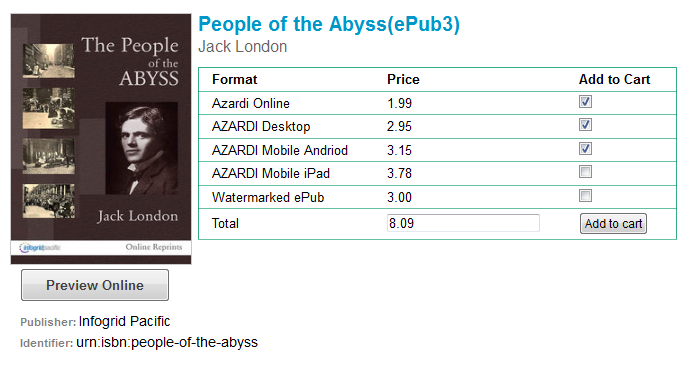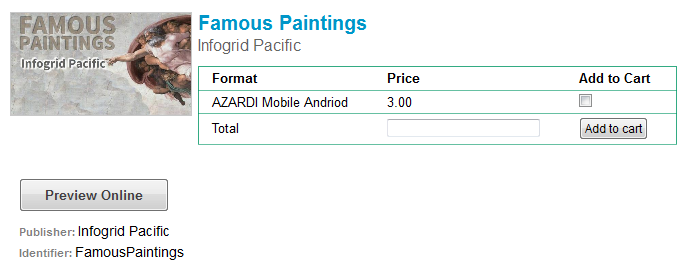Selling ePubs on Multiple Platforms
27 January 2013
How do you sell your ePub2/3 content from one source, for all platforms, devices and browsers with content security? There are many interesting dimensions to the multi-platform content delivery business problem which have not required much thinking through in the past; not least the buying (or selling) interface. AZARDI:Content Fulfilment is designed to address this new, interesting and challenging business problem.
How do you sell your ePub2/3 content from one source, for all platforms, devices and browsers with content security?
There are many interesting dimensions to the multi-platform content delivery business problem which have not required much thinking in the past; not least the buying (or selling) interface. AZARDI:Content Fulfilment is designed to address this new, interesting and challenging business problem.
This post does NOT consider the print edition at all. That model is well understood.
Enter: The Option
AZARDI:Content Fulfilment (ACF) offers a publisher an alternative to the current device locked sales channels by giving them full control over the sales model (their own book store integrated into their own site), their own pricing model, and no third party profit charge. It really is freedom.
The obvious "discovery" issues when operating your own bookstore remains hanging, but we don't want to get into that "chicken and eggs" what should come first dialogue. Search and discovery have to sort themselves out. ACF is the egg from which new business can hatch.
On top of that 2013 is the year that we probably really start to believe "they all" manipulate their search results. "They all" is Google, Amazon, Apple, Bing, etc. Liz Castro blogged on this recently in her post "We're Not the Media if We Depend on Google (or Amazon)".
The market is changing. Currently nearly every book selling option is about sales channel lock-in, device lock-in or reading system lock-in. Everyone wants a percentage of the publisher's business... and then "expert" rhetoric is painted into the dialogue making publishers the bad guys, and authors the heroes, DRM evil and anti-consumer, while throwing in the relatively irrelevant publisher vs. self-publisher stuff. (Partisan rant over!)
Today a publisher has two choices:
- Ignore the e-retail channels and go with watermarked ePubs (or use the e-retail channels and still use watermarking as an custom option).
- Buy into the e-retailer model and upload books to the various e-retailers on their terms.
Reading System Consistency Across All Platforms
The main objective of ACF is to eliminate the costs and complexity of the content delivery to the strange lands of multiple devices, multiple platforms and multiple reading systems.
It is obvious that ePub2/3 will never achieve this except with the most simple content. What is needed is ePub2/3 PLUS consistency of reading system performance and features on all platforms and devices.
That is what ACF delivers for the publisher.
AZARDI:Content Fulfilment unleashes full publisher control over their business to consumers. The ACF business model is no per sales fees or sales percentages. Publisher's may not have a tradition of working directly with consumers but now they have an affordable technology suite to learn!
Install the software and keep all the book revenue. The SaaS model is around $20 per annum per book (10 book minimum) for management and bandwidth, and the publisher keeps all the book sales revenue. ACF doesn't even buy into the e-commerce closure.
ACF is designed primarily for controlled channel content delivery. It allows individual books, collections of books and courseware to be sold as products by the publisher using different product permutations and methods.
Working With the Holes
The good news for publishers is the fact that each of the major "players" in e-retail are locked into their respective platforms. They now have to capitalize on the tremendous growth and competition in the tablets and phablets markets.
Those devices which are open are easy to work with (Samsung et al). With the closed systems, (Apple and Amazon, Kobo, Nook, etc.), WebApps and Installable apps respectively solve the problem.
The Delivery Packages
To put this in perspective. ACF offers controlled content deliver to the following ePub platform reading systems:
- Online Preview
- Online Reading (Firefox, Google Chrome, Internet Explorer, Opera, Safari)
- Desktop reader (Windows, Mac, Linux)
- Android App (from Google store or as an installable app for Kindle Tablets).
- Apple iOS WebApp
- Watermarked ePub2/3
That covers just about everything and everyone with the exception of Windows RT which will probably be a WebApp.
How Does ACF Deliver the Content
A discussion on "DRM" is for another time and place but ACF does not deliver an open ePub file. The ePub is pre-processed to an optimized delivery package optimized for storage and presentation.
This transfer and storage method is ideal for channel controlled content sold on subscription, or library lending content.
I will discuss the offers, agreements and rights issues in a separate post sometime in the future.
The Selling Interface
That makes the selling options a little more intensive than a normal book store. Here is one of the interface options for purchasing a book with each format priced differently. The customer can purchase any combination and pay the total.

Selling Option 1. This is a development server shot showing the book able to be purchased for multiple reading systems each with a custom price. The customer can select what they need or want.

Selling Option 2. Segregate products by delivery platform. Here is a product that only offers the Mobile Android option. The organization of offer catalogues can be by title or by reading option, or any other combination. Selling only for online access is a common requirement for manuals and training material.
When your ePub is uploaded to the ACF system it is multi-packaged ready for secure delivery to all reading systems instantly and ready for delivery.
Creating Products from ePubs
We use the term formats here a little incorrectly. A format means an ePub2/3 packaged for a target devices AZARDI reader.
To convert the ePub into a bookstore or portal delivery it must be turned into a product. That means adding agreement terms and most importantly prices.
There is a wide range of product building options available for a publisher.
All formats, One Price. Sell consolidated delivery format for one price. The user pays once and has can access all six delivery formats. This option is primarily for courseware rather than normal book sales.
All formats same price. User selects required format(s). Sell all delivery packages at the same price. The purchased delivery formats can be just those the customer wants for their platform(s).
Formats different prices. User selects required formats(s). Sell all delivery formats at different prices. This may be required with online and watermarked epubs which may attract a premium. It can also be used to offer a free promotional format.
A limited list of delivery formats. For channel agreement or marketing reasons create a product with restricted formats. For example, "Our Hot Spring Book Sale for Android Tablet owners".
ACF supports Book, Collection and Courseware products
Books you can see above. The product on offer contains only a single title, but in multiple reading system options.
Collections is a single product that has multiple books or documents. It could be an omnibus book set, a series, or a subject grouping of some sort. But an ACF collection is still delivered by independent book delivery formats. So if you made a collection with 10 books and offered it in all formats, that would be 50 downloadable formats the system has to manage for each purchase. Add subscriptions to this and it goes crazy. ACF handles this problem elegantly.
Courseware is the purchase of access to a Course Portal which contains any number of books/documents in ePub3 package formats. For example it Could be for 6th Standard (Grade) for a specific institution and contain books on language, maths, science, social studies with textbooks and exercise books. Each book is available in all the formats the publisher wants or needs to supply to the target institution.
Reading System Format Context
In the users book-store account they see all these formats, but when they log into a book-store with a device reading system they only see the downloads for that format. For example, logging into an account with an Android will only show books that have been purchased for the Android device.
Education and training content publishers have this problem right now. One book, delivered securely to multiple platforms.
Other publishers may be going to face this problem more and more into the future as they look for selling options that do not require e-retailer outlets.
Summary
Selling a book to every possible browser, platform and device, including new things that come up in an unpredictable future needs a reading system that works on all browsers, platforms and devices. In a delivery system such as AZARDI:Content Fulfilment the reading system is in fact more important that the ePub format.
AZARDI is comfortable using just standards compliant HTML5, CSS-3 and Javascript without any ePub overhead. This is an important business flexibility option for publishers in the future in the coming ePub3 feature diaspora, especially with fixed-layout, crazy features and lazy implementations of the core reading features.
Advanced and flexible presentation customization of the reading experience is the most important reading system feature in this fast device changing world if all platforms are to be addressed.
From the beginning AZARDI was designed to be consistent across platforms to enable end-users to immediately and interactively customize the reading experience for any combination of device and content complexity. Presentation options have to allow personally optimized content reading experiences on phones, phablets, tablets with different aspect ratios, desktop windows of any shape and size and browser windows of any shape and size. AZARDI does exactly that.
In Conclusion
The AZARDI journey began in 2007. It is now a complete digital content delivery solution for publishers of all sizes who need to have full control of their content using both sales and subscription models.
The AZARDI:Content Fulfilment demonstration book-stores with self-managed accounts will be available for publishers shortly.
If you are a bona-fide publisher or library let us know if you are interested in knowing more or trying the system out. Priority and preference will of course be given to IGP:Digital Publisher licensees and Portal users.